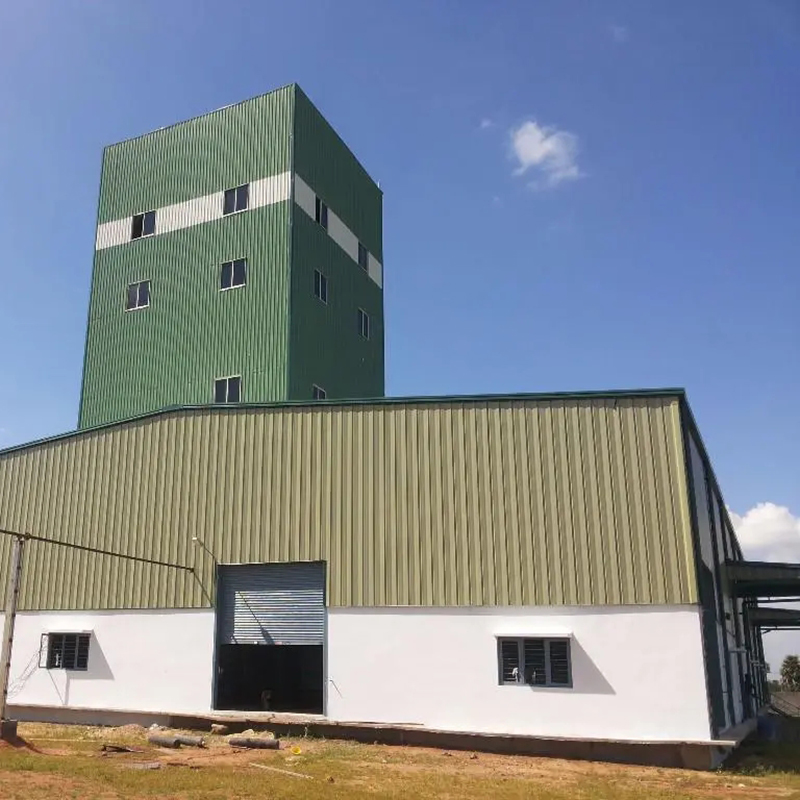The main and secondary steel structures are sand painted according to the requirements of anti-corrosion. The amount of paint is related to the thickness of dry film to a large extent, and also related to the construction method and coating system (the loss rate of spraying is higher than that of manual brush). The following data is the theoretical coating rate (for reference only), and the actual amount is multiplied by a coefficient of 1.5-1.8:
75Micron thickness, about 8.5 m2 / L;
125Micron thickness, about 6.5 m2 / L;
200Micron thick, about 4 square meters per liter.
It is usually measured in volume units.
There is a theoretical coating rate in the paint specification, that is, how many l of paint is used to apply 100um (or 50um, etc.) per square meter.For example, this number is x%
Then the amount of paint = x% * 25000 * paint thickness / 100
Then you multiply the result by a loss factor, such as 1.3, which generally has something to do with the construction equipment.
The net weight of weld on steel structure is about 1.5-2% of steel member.Then according to this, the weight of the electrode is increased because of its net weight. In addition to the weight of the electrode head and coating left, the weight of the electrode is generally 1.8-2.2 times.
Estimation method of steel structure paint consumption
The theoretical coating rate and the actual coating rate formula of a paint are the area covered by a liter of paint on a completely smooth and flat glass surface without pores to form a specified dry film thickness.
Theoretical coating rate = solid volume content * 10 / dry film thickness (μ m) (m2 / L)
In the actual project construction, due to the influence of various factors such as the surface shape of the construction workpiece, required paint film thickness, construction method, worker technology, construction environmental conditions, weather and other factors, the actual amount of paint used must be greater than the “theoretical use amount” calculated by dividing the construction area by the theoretical coating rate.
Actual / theoretical paint usage (this ratio is defined as the “loss factor” CF.)
Actual amount of Engineering paint = construction area / actual coating rate = construction area * CF / theoretical coating rate = theoretical use amount × CF “loss coefficient” CF analysis and estimation: paint loss caused by workpiece surface roughnessWhen spraying the surface, the film thickness at the wave crest of the steel plate is less than that at the trough. In order to meet the anti-corrosion thickness requirements at the wave crest (to avoid pitting corrosion), the paint “hidden” in the trough is equivalent to being lost, which is called “loss of steel plate roughness”.The following table shows paint loss caused by different spraying methods (expressed by dry film thickness)
Paint loss caused by uneven distribution of paint film thickness after construction, when the film thickness reaches or exceeds the specified film, the technical service representative, the supervisor or the owner will sign according to the normal qualification, but the part that fails to reach the specified film thickness will be required to be repainted, so it will inevitably cause “over thickness” loss.The main factors that lead to uneven distribution of paint film thickness are: worker’s proficiency, construction environment, simple (plane workpiece) or complex construction work piece, and construction method (no air spraying, air spraying, brush coating, rolling coating).Construction waste construction waste refers to the waste that the paint does not reach the surface of the construction workpiece and is lost to the surrounding environment or ground.If there is no air spraying, about 10-20% of the paint is lost, more than 50% of the paint is lost by air spraying, and about 5% of the paint is lost by roller coating. When the brushing is well controlled, the painting of bridges in windy environment can cause more than 100% waste.
Waste of residual paint in the container, the average loss value of paint remaining in the inner wall of paint barrel and rubber tube is about 5%.To sum up, the paint loss coefficient in construction is mainly caused by surface roughness loss of workpiece, uneven distribution of paint film thickness, construction waste and waste of residual paint in container.
Post time: Jul-10-2020

